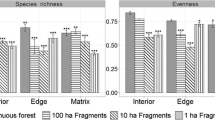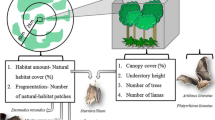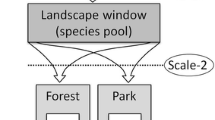Abstract
Context
Scale dependence of bat habitat selection is poorly known with few studies evaluating relationships among landscape metrics such as class versus landscape, or metrics that measure composition or configuration. This knowledge can inform conservation approaches to mitigate habitat loss and fragmentation.
Objectives
We evaluated scale dependence of habitat associations and scaling patterns of landscape metrics in relation to bat occurrence or capture rate in forests of southwestern Nicaragua.
Methods
We captured 1537 bats at 35 locations and measured landscape and class metrics across 10 spatial scales (100–1000 m) surrounding capture locations. We conducted univariate scaling across the 10 scales and identified scales and variables most related to bat occurrence or capture rate.
Results
Edge and patch density, at both landscape and class levels, were the most important variables across species. Feeding guilds varied in their response to metrics. Certain landscape and configuration metrics were most influential at fine (100 m) and/or broad (1000 m) spatial scales while most class and composition metrics were influential at intermediate scales.
Conclusions
These results provide insight into the scale dependence of habitat associations of bat species and the influence of fine and broad scales on habitat associations. The effects of scale, examined in our study and others from fine (100 m) to broad (5 km) indicate habitat relationships for bats may be more informative at larger scales. Our results suggest there could be general differences in scale relationships for different groups of landscape metrics, which deserves further evaluation in other taxonomic groups.







Similar content being viewed by others
References
Akasaka T, Akasaka M, Nakamura F (2012) Scale-independent significance of river and riparian zones on three sympatric Myotis species in an agricultural landscape. Biol Conserv 145:15–23
Albrecht L, Meyer CFJ, Kalko EKV (2007) Differential mobility in two small phyllostomid bats, Artibeus watsoni and Micronycteris microtis, in a fragmented neotropical landscape. Acta Theriol 52:141–149
Bobrowiec PED, Gribel R (2009) Effects of different secondary vegetation types on bat community composition in Central Amazonia, Brazil. Anim Conserv 13:204–216
Chambers CL, Herder MJ, Yasuda K, Mikesic DG, Dewhurst SM, Masters WM, Vleck D (2011) Roosts and home ranges of spotted bats (Euderma maculatum) in northern Arizona. Can J Zool 89:1256–1267
Cisneros LM, Fagan ME, Willig MR (2015) Season-specific and guild-specific effects of anthropogenic landscape modification on metacommunity structure of tropical bats. J Anim Ecol 84:373–385
Clarke FM, Pio DV, Racey PA (2005) A comparison of logging systems and bat diversity in the Neotropics. Conserv Biol 19:1194–1204
Corbett RJM, Chambers CL, Herder MJ (2008) Roosts and activity areas of Nyctinomops macrotis in northern Arizona. Acta Chiropterol 10:323–329
Cushman SA, McGarigal K (2002) Hierarchical, multi-scale decomposition of species–environment relationships. Landscape Ecol 17:637–646
Cushman SA, McGarigal K (2003) Landscape-level patterns of avian diversity in the Oregon Coast Range. Ecol Monogr 73:259–281
Cushman SA, McGarigal K, McKelvey K, Reagan C, Demeo T, Vojta C (2013b) Landscape analysis for habitat monitoring. In: Vojta C (ed) USFS Wildlife Habitat Technical Guide, chap 6
Cushman SA, McGarigal K, Neel MC (2008) Parsimony in landscape metrics: strength, universality and consistency. Ecol Ind 8:691–703
Cushman SA, Shirk AJ, Landguth EL (2013a) Landscape genetics and limiting factors. Conserv Genet 14:263–274
de Boer WF, van de Koppel S, de Knegt HJ, Dekker JJA (2013) Hibernation site requirements of bats in man-made hibernacula in a spatial context. Ecol Appl 23:502–514
Dent DH (2010) Defining the conservation value of secondary tropical forests. Anim Conserv 13:14–15
Elliot NB, Cushman SA, Macdonald DW, Loveridge AJ (2014) The devil is in the dispersers: predictions of landscape connectivity change with demography. J Appl Ecol 51:1169–1178
Estrada A, Coates-Estrada R (2002) Bats in continuous forest, forest fragments and in an agricultural mosaic habitat-island at Los Tuxtlas, Mexico. Biol Conserv 103:237–245
Estrada-Villegas S, Meyer CFJ, Kalko EKV (2010) Effects of tropical forest fragmentation on aerial insectivorous bats in a land-bridge island system. Biol Conserv 143:597–608
Fahrig L (1997) Relative effects of habitat loss and fragmentation on population extinction. J Wildl Manag 61:603–610
Fenton MB, Acharya L, Audet D, Hickey MBC, Merriam C, Obrist MK, Syme DM (1992) Phyllostomid bats (Chiroptera: Phyllostomidae) as indicators of habitat disruption in the Neotropics. Biotropica 24:440–446
Gillespie TW, Grijalva A, Farris CN (2000) Diversity, composition, and structure of tropical dry forests in Central America. Plant Ecol 147:37–47
Gillespie TW, Walter H (2001) Distribution of bird species richness at a regional scale in tropical dry forest of Central America. J Biogeogr 28:651–662
González-Rivas B, Tigabu T, Gerhardt K, Castro-Marín G, Odén PC (2006) Species composition, diversity and local uses of tropical dry deciduous and gallery forests in Nicaragua. Biodivers Conserv 15:1509–1527
Gorresen PM, Willig MR (2004) Landscape responses of bats to habitat fragmentation in Atlantic forest of Paraguay. J Mammal 85:688–697
Gorresen PM, Willig MR, Strauss RE (2005) Multivariate analysis of scale-dependent associations between bats and landscape structure. Ecol Appl 15:2126–2136
Grand J, Buonaccorsi J, Cushman SA, Griffin CR, Neel MC (2004) A multiscale landscape approach to predicting bird and moth rarity hotspots in a threatened pitch pine-scrub oak community. Conserv Biol 18:1063–1077
Griscom HP, Ashton MS (2011) Restoration of dry tropical forests in Central America: a review of pattern and process. For Ecol Manag 261:1564–1579
Griscom HP, Ashton PMS, Berlyn GP (2005) Seedling survival and growth of native tree species in pastures: implications for dry tropical forest rehabilitation in central Panama. For Ecol Manag 218:306–318
Hansen MC, Stehman SV, Potapov PV (2010) Quantification of global gross forest cover loss. Proc Natl Acad Sci USA 107:8650–8655
Harestad AS, Bunnel FL (1979) Home range and body weight—a reevaluation. Ecology 60:389–402
Harvey CA, Medina A, Merlo Sánchez D, Vílchez S, Hernández B, Saenz JC, Maes JM, Casanoves F, Sinclair FL (2006) Patterns of animal diversity in different forms of tree cover in agricultural landscapes. Ecol Appl 16:1986–1999
Heithaus ER, Fleming TE (1978) Foraging movements of a frugivorous bat, Carollia perspicillata (Chiroptea: Phyllostomidae). Ecol Monogr 48:127–143
Herrerías-Diego Y, Quesada M, Stoner KE, Lobo JA, Hernández-Flores Y, Montoya GS (2008) Effect of forest fragmentation on fruit and seed predation of the tropical dry forest tree Ceiba aesculifolia. Biol Conserv 141:241–248
Hood CS, Knox Jones Jr J (1984) Noctilio leporinus. Mamm Species 216:1–7
Hutson AM, Mickleburgh SP, Racey PA (comp) (2001) Microchiropteran bats: global status survey and conservation action plan. IUCN/SSC Chiroptera Specialist Group. IUCN, Gland
Janzen DH (1988) Management of habitat fragments in a Tropical Dry Forest: growth. Ann Mo Bot Gard 75:105–116
Johnson D (1980) The comparison of usage and availability measurements for evaluating resource preference. Ecology 61:65–71
Klingbeil BT, Willig MR (2009) Guild-specific responses of bats to landscape composition and configuration in fragmented Amazonian rainforest. J Appl Ecol 46:203–213
Kodandapani N, Cochrane MA, Sukumar IR (2008) A comparative analysis of spatial, temporal, and ecological characteristics of forest fires in seasonally dry tropical ecosystems in the Western Ghats, India. For Ecol Manag 256:607–617
Kunz TH, Kurta A (1988) Capture methods and holding devices. In: Kunz TH (ed) Ecological and behavioral methods for the study of bats. Smithsonian Institution Press, Washington, pp 1–28
Lacki MJ, Baker MD, Johnson JS (2010) Geographic variation in roost-site selection of long-legged Myotis in the Pacific Northwest. J Wildl Manag 74:1218–1228
Levin SA (1993) The problem of pattern and scale in ecology: the Robert H. MacArthur Award Lecture. Ecology 73:1943–1967
Mateo-Sanchez MC, Cushman SA, Saura S (2014) Scale dependence in habitat selection: the case of the endangered brown bear (Ursus arctos) in the Cantabrian Range (NW Spain). Int J Geogr Inf Sci 28:1531–1546
McCrary JK, Walsh B, Hammett AL (2005) Species, sources, seasonality, and sustainability of fuelwood commercialization in Masaya, Nicaragua. For Ecol Manag 205:299–309
McGarigal K, Cushman SA (2005) The gradient concept of landscape structure. In: Wiens J, Moss M (eds) Issues and perspectives in landscape ecology. Cambridge University Press, Cambridge, pp 112–119
McGarigal K, Cushman SA, Neel, MC, Ene E (2002) FRAGSTATS: spatial pattern analysis program for categorical maps. Computer Software Program produced by the authors at the University of Massachusetts, Amherst. http://www.umass.edu/landeco/research/fragstats/fragstats.html
McGarigal K, Cushman SA, Ene E (2013) FRAGSTATS v4: spatial pattern analysis program for categorical and continuous maps. Computer Software Program produced by the authors at the University of Massachusetts, Amherst. http://www.umass.edu/landeco/research/fragstats/fragstats.html
McGarigal K, Wan HI, Zeller KA, Timm BC, Cushman SA (2016) Multi-scale habitat modeling: a review and outlook. Landscape Ecol (in press)
McNab BK (1963) Bioenergetics and the determination of home range size. Am Nat 97:133–140
Medellín RA, Equihua M, Amin MA (2000) Bat diversity as indicators of disturbance in neotropical rainforests. Conserv Biol 14:1666–1675
Medina A, Harvey CA, Sánchez Merlo D, Vílchez S, Hernández B (2007) Bat diversity and movement in an agricultural landscape in Matiguás, Nicaragua. Biotropica 39:120–128
Medina-Fitoria A (2014) Murciélagos de Nicaragua. Guía de campo. Programa para la Conservación de los Murciélagos de Nicaragua (PCMN) y Ministerio del Ambiente y los Recursos Naturales (MARENA)
Meyer CFJ, Frund J, Lizano WP, Kalko EKV (2008) Ecological correlates of vulnerability to fragmentation in neotropical bats. J Appl Ecol 45:381–391
Miles L, Newton A, Defries R, Ravilious C, May I, Blyth S, Kapos V, Gordon JE (2006) A global overview of the conservation status of tropical dry forests. J Biogeogr 33:491–505
Montiel S, Estrada A, Leon P (2006) Bat assemblages in a naturally fragmented ecosystem in the Yucatan Peninsula, Mexico: species richness, diversity and spatio-temporal dynamics. J Trop Ecol 22:267–276
Myers JL, Well AD, Lorch Jr RF (2010) Research design and statistical analysis, 3rd edn. Routledge, New York
Neel MC, McGarigal K, Cushman SA (2004) Behavior of class-level metrics across gradients of class aggregation and area. Landscape Ecol 19:435–455
Peters SL, Malcolm JR, Zimmerman BL (2006) Effects of selective logging on bat communities in the southeastern Amazon. Conserv Biol 5:1410–1421
Razgour O, Hanmer J, Jones G (2011) Using multi-scale modelling to predict habitat suitability for species of conservation concern: the grey long-eared bat as a case study. Biol Conserv 144:2922–2930
Reid FA (2009) A field guide to the mammals of Central America and southeast Mexico, 2nd edn. Oxford University Press, Oxford
Rivas C, Stevens B, Wang O (2013) A spatial model of dominant vegetation types within the land of Paso del Istmo Corridor in southwestern Nicaragua. Final Summary Report to Paso Pacifico. Laboratory of Landscape Ecology and Conservation Biology, Northern Arizona University, Flagstaff
Romero-Duque LP, Jaramillo VJ, Pérez-Jiménez A (2007) Structure and diversity of secondary tropical dry forests in Mexico, differing in their prior land-use history. For Ecol Manag 253:38–47
Ryan DA (1978) Recent development of national parks in Nicaragua. Biol Conserv 13:179–182
Sabogal C (1992) Regeneration of tropical dry forests in central America, with examples from Nicaragua. J Veg Sci 3:407–416
Sesnie SE, Hagell S, Otterstrom S, Chambers CL, Dickson BJ (2008) SRTM-DEM and Landsat ETM+ data for mapping tropical dry forest cover and biodiversity assessment in Nicaragua. Rev Geogr Acad 2:53–65
Shirk AJ, Raphael MG, Cushman SA (2014) Spatiotemporal variation in resource selection: insights from the American marten (Martes americana). Ecol Appl 24:1434–1444
Sikes RS, Gannon WL, the Animal Care and Use Committee of the American Society of Mammalogists (2011) Guidelines of the American Society of Mammalogists for the use of wild mammals in research. J Mammal 92:235–253
Thompson CM, McGarigal K (2002) The influence of research scale on bald eagle habitat selection along the lower Hudson River, New York (USA). Landscape Ecol 17:569–586
Timm RM, LaVal RK (1998) A field key to the bats of Costa Rica. Occasional Publication Series Center of Latin American Studies, The University of Kansas, No. 22, pp 1–30
Tucker MA, Ord TJ, Rogers TL (2014) Evolutionary predictors of mammalian home range size: body mass, diet and the environment. Glob Ecol Biogeogr 23:1105–1114
Villard MA, Trzcinski MK, Merriam G (1999) Fragmentation effects on forest birds: relative influence of woodland cover and configuration on landscape occupancy. Conserv Biol 13:774–783
Wasserman TN, Cushman SA, Wallin DO, Hayden J (2012) Multi-scale habitat relationships of Martes americana in northern Idaho, USA. USDA Forest Service RMRS-RP-94
Wiens J (1989) Spatial scaling in ecology. Funct Ecol 3:385–397
Willig MR, Presley SJ, Bloch CP, Hice CL, Yanoviak SP, Diaz MM, Chauca LA, Pacheco V, Weaver SW (2007) Phyllostomid bats of lowland Amazonia: effects of anthropogenic alteration of habitat on abundance. Biotropica 39:737–746
Wilson DE, Ascorra CF, Solari TS (1996) Bats as indicators of habitat disturbance. In: Wilson DE, Sandoval A (eds) Manu. The biodiversity of Southeastern Peru. Editorial Horizonte, Lima, pp 613–625
With KA, King AW (1999) Extinction thresholds for species in fractal landscapes. Conserv Biol 13:314–326
Zeller KA, McGarigal K, Beier P, Cushman SA, Vickers TW, Boyce WM (2014) Sensitivity of landscape resistance estimates based on point selection functions to scale and behavioral state: pumas as a case study. Landscape Ecol 29:541–557
Acknowledgments
We thank the Bat Conservation International and the Percy Sladen Memorial Fund for financial support. Paso Pacífio provided logistic and field support. We thank landowners who provided access to their property for this work including Miguel Melendez and Miguel Soto. We thank J. Crouse for the study area map. Volunteers who helped capture, identify, and radio track bats included D. Brown, B. Burger, C. Corben, K. Day, A. Haskew, K. Livengood, A. McIntire, B. Noble, L. Piest, E. Rutherford, M. Siders, D. Sinton, T. Snow, B. Taubert, D. Taylor, S. Tuttle, and K. Williams-Guillén. The Associate Editor and 2 anonymous reviewers provided comments that greatly improved the manuscript.
Author information
Authors and Affiliations
Corresponding author
Electronic supplementary material
Below is the link to the electronic supplementary material.
Rights and permissions
About this article
Cite this article
Chambers, C.L., Cushman, S.A., Medina-Fitoria, A. et al. Influences of scale on bat habitat relationships in a forested landscape in Nicaragua. Landscape Ecol 31, 1299–1318 (2016). https://doi.org/10.1007/s10980-016-0343-4
Received:
Accepted:
Published:
Issue Date:
DOI: https://doi.org/10.1007/s10980-016-0343-4




